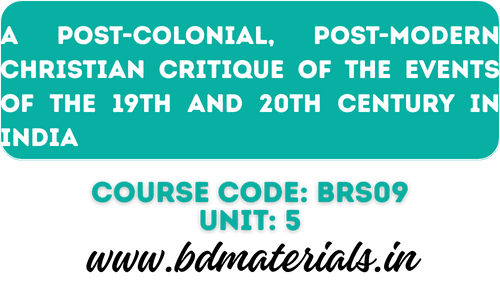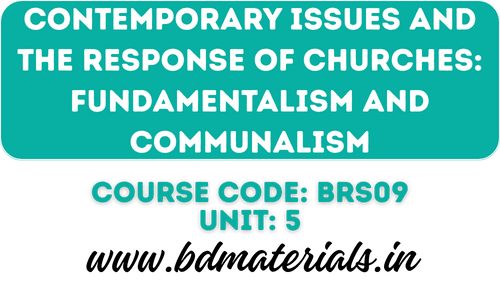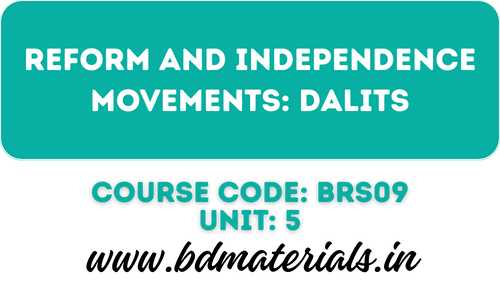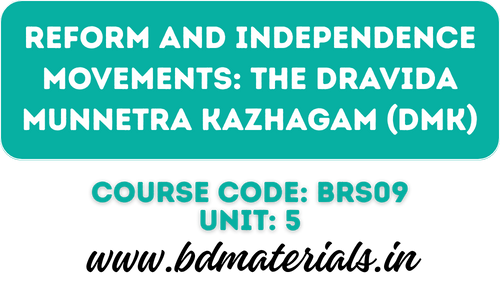A Post-Colonial, Post-Modern Christian Critique of the Events of the 19th and 20th Century in India
- An age of transition: The urgent need for social and religious reform that began to manifest itself from the early decades of the 19th century arose in response to the contact with Western culture and education. The weakness and decay of Indian society was evident to educated Indians who started to work systematically for their removal. They were no longer willing to accept the traditions, beliefs and practices of Hindu society simply because they had been observed for centuries. The impact of Western ideas gave birth to new awakening. The change that took place in the Indian social scenario is popularly known as the Renaissance.
All transitional movements advocated some degrees of change and consequently generated discord in one or more areas of life. Often associated with this conflict was a clarifying and hardening of boundaries between religious communities and the defining of sectarian positions within a given religion. - Attempt to return to past purity through protest: All but one of these movements declared their aims as a ‘return to past purity’. Among Hindus the power of Brahman priests, the rituals they conducted, idol worship, the limited and subordinate role of women, polytheism, and the caste system were condemned repeatedly as they had been over many centuries. Muslim leaders arose who called for a return to purity and the rejection of erroneous customs and innovations. Sikhs too sought to remove various ‘false’ customs and forms of worship as shown by the Nirankaris’ return to the Sikhism of Guru Nanak or the attempts of the Namdharis to revive the panth.
- Emergence of acculturative movements: The emergence of acculturative movements within the colonial milieu was both a continuation of socio-religious dissent, and a modification of this tradition. Those, who could not ignore these new rulers but who depended on them for their social and economic position, found ways to restructure their own cultural heritage in order to retain a place within that heritage. They could neither ignore the English nor could they join British society and find acceptance within it. The English brought a new civilization, but one that was itself undergoing rapid and escalating change. English culture contained tensions between older patterns of life and ‘new’ forms of social, political, and economic expression undergirded by developments in science and technology. Within western thought this new knowledge, and all that accompanied it, was understandable by the concept of ‘progress’, an idea foreign to South Asia. Members of the educated elite accepted this concept readily as they strove to possess the ‘progress’ and ‘modernity’ owned by the British. These movements supplied a way in which ‘progress’ could be achieved and legitimized. The path to a better future lay in a return to a pure and proper past; to the ‘fundamentals’ of religion as presented in ancient texts once those texts were properly understood and comprehended. Individuals needed the guidance of inspired men and their disciples, but once the path was given and the signposts erected, then a new and better world could be achieved by turning back to the righteous past.
- Changing perspectives upon Christianity: Science and technology posed few problems for South Asian religious thinkers. It was more difficult to answer the challenges of western superiority and the allied threat of Christian conversion. Military and technological dominance were linked in British imperialist ideology to claims of racial and religious superiority. By the second half of the nineteenth century, Christianity was fused with the Raj and had become an integral part of the imperial English culture.
Indian religious leaders articulated three different positions in response to Christian insistence that they alone possessed religious truth, and were compelled to convert all non-Christians to that truth. Ram Mohan Roy argued for an equivalence between Christianity and Hinduism based on the ethical core of each religion. Both were en- crusted with superstition, error, and mistaken forms of ritual, but once these were removed, the two religions stood on an equal footing.Others, such as Ramakrishna, Keshab Chandra Sen, and Swami Vivekananda, insisted that all religions were true and, like the spokes of a wheel, led by different paths to the same ultimate reality. This doctrine justified remaining in the religion of one’s birth and made conversion unnecessary. Both arguments denied the superiority of Christianity. By far the largest group of religious leaders – Muslim, Hindu, Parsi, and Sikh – maintained that their particular brand of religion was superior to Christianity. This they could ‘prove’ by using their own set of religious beliefs as the normative measure for all religions. The controversies generated by opposing religious groups took new forms and intensity when South Asian religions successfully adopted the technology of printing. - Protestantization – Promotion of Vernacular Literature and Education: The production of inexpensive printed texts accelerated the translation of scriptures and commentaries into the vernacular languages to make them available to a wider audience than could respond to material written in Sanskrit, Arabic, or Persian. English was also used, but this could only reach a small elite of English literates. The vernaculars offered a wider audience, but still an audience limited to those who were literate. Consequently, education became an increasing necessity driven by a dependence on the printed word. Socio-religious movements utilized printing and translation. They also produced a stream of didactic and polemical literature that explained the newly translated texts, elaborated on their ideologies, and defended them from critics within and without their own religious community. The availability of a printed text encouraged the creation of creeds that summarized a complex set of teachings, and furnished a basic statement of belief for the disciples of a particular movement.The patterns of religious authority were modified by printing since texts became available to anyone who was literate, as did the ‘right’ to speak out on religious issues through inexpensive pamphlets and tracts. Neither Brahmans, Parsi priests, nor the ulama had a monopoly of religious authority. Challenges to these groups had appeared in centuries past, but with printing those who acted in opposition could do so far more effectively. Printing, translation, and literacy combined to create a framework, in many ways parallel to the Protestant Reformation in Europe with its abandonment of classical Latin, its proliferation of translations and religious writings, and its insistence that the devout read scriptures as an essential part of their search for salvation. As in Protestantism, many of the socio-religious movements of South Asia taught that truth lay in the text, and that it was the duty of their adherents to study these writings in order to find within them a key to a proper, moral and spiritual life.
- Differing goals and programmes: The socio-religious movements of the British period added new dimensions to the existing religions of India. All religions gained a greater degree of social service as movements undertook such tasks as forms of disaster relief, the construction of schools, orphanages, and hospitals. The Ramakrishna Math and Mission, with its system of hospitals and dispensaries, and its extensive relief projects, added to Hinduism a dogma of social service and a successful programme based on that dogma. The Arya Samaj brought to Hinduism not only a system of proselytism with professional missionaries, but a ritual of conversion by which anyone could become a Hindu. Thus their redefined Hinduism could compete openly with conversion religions. The Ahmadiyahs and Radhasoami Satsangis transformed the traditional religious centres into model religious cities at Beas, Agra, and Qadiyan with industrialization and commerce as well as religious teachings.
Socio-religious movements among untouchables, whether transitional or acculturative, followed a pattern that began with attempts to improve the status of a particular caste, went through a period of aggressive attacks on the overall structure of society. - An Age of Expansion: From the late nineteenth century to the twentieth, there was an increased internationalization of South Asian socio-religious movements. Emigration and the conversion of individuals outside the subcontinent accounted for the extension of South Asian socio-religious movements into the rest of the world. The conversion of non-Hindus brought new opportunities and problems to Hinduism, especially when it came to integrating converts into the Hindu social structure. The post-Independence period has seen a continuation of this internationalizing of religions as emigration has carried orthodox Hinduism, Islam, and Sikhism abroad, as well as socio-religious movements from all three communities.
- Rise of religious fundamentalism: All socio-religious movements, transitional, acculturative or orthodox-defensive, were fundamentalist, i.e. they sought a return to what each considered the ‘fundamentals’ of their religion. In Hinduism the Brahmos rejected much of Hinduism and saw the Upanishads as the legitimate source of religious authority. The Aryas went one step further to the Vedas as their ultimate container of religious truth and, in the process, condemned almost the whole of popular Hinduism. Fundamentalism then referred to a process of winnowing down religious authority and practice as group after group defined what was true and used those authorities to justify their doctrines of return to the ‘truth’.
- Emergence of Communalism and Religious Nationalism: The British-Indian government exacerbated religious conflict through various actions of its own, although in numerous instances it is doubtful that they had any idea what might result from those actions. The initiation of the decennial census in 1871 set about a process that redefined religion. Each census defined, counted, and described the major religious com munities, and the ‘recognized’ socio- religious movements, that is, those important enough to have been listed in the census. To be discussed in the census reports gave an official recognition of a movement’s existence and importance; but, above all else, the comparative rates of growth measures whether or not a religion was succeeding or failing.
Administrative and political acts by the government often heightened religious competition and the identification of individuals with a particular set of religious beliefs. The creation of municipal councils during this same period brought into existence a new arena of religious competition as individuals on these bodies acted as representatives of their respective religious communities, rather than of themselves or of secular interests. It was, however, the constitutional reforms of 1909 that fused, once and for all, religion, the census, and political patronage into a single system. The granting of separate electorates to Muslims necessitated the definition of that religious community and its enumeration, an act that could only be done by the Indian census. The extension of these separate electorates in 1919 and 1935 to religious, social, racial, and various interest groups further tied religion to the political system.
The religious upheavals of the nineteenth century, with their debates, creeds, and various forms of competition, led to a growing sense of belonging to a particular sectarian movement and, beyond that, to membership in a broader religious community. This sense of communal identity grew in intensity and came from a variety of sources as the century progressed. Most fundamentally the desire to find and resur- rect a past purity, when conducted in a multi-religious society, meant that, inevitably, the practices and beliefs of other religions were seen as intrusive influences responsible for contemporary decadence and error. Politicization of religion: With the fusion of religion and politics, each of the major communities developed their own political organizations that spoke for the religious group and competed with other political bodies. Feeding into this process of the politicization of religion was the intensification of religious identity and loyalty to the religious group. This consciousness rested on a sense of belonging to one body of people and of being different from all others. In it existed a potential for nationalism, which was a political expression of separate identity.
Within the context of nation states, technological development, urbanization, and a vast variety of changes in many elements of daily life, the tradition of protest and dissent persists. Those who seek to restructure society now do so in terms of religious symbols and authority, as they have done for centuries. Religious dissent has been modified and at times blended with various secular ideas to produce new ideologies of protest. Yet religion in itself remains a powerful vehicle for the mobilization of human resources. It is within this increasingly complex world that the many forms of religious protest, drawn from three different civilizations, will continue to make themselves felt within India.
Friendly Note
Bachelor of Divinity Materials is your go-to resource for comprehensive Biblical studies, supporting students in Bachelor of Divinity (B.D.) and other theological courses. Our platform offers access to the full syllabus, detailed answers, and a vast collection of assignments, study guides, articles, and research papers to help you excel academically.
We provide downloadable PDFs of study materials, including books and journals, for convenient learning anytime, anywhere. Whether preparing for exams or conducting research, our resources cater to both students and scholars in biblical studies.
Committed to empowering theological learners, we aim to deliver high-quality, authentic study materials. Explore Bachelor of Divinity Materials to deepen your understanding of God’s Word and Christian doctrine, making it a valuable resource for aspiring ministers and anyone dedicated to theology.






